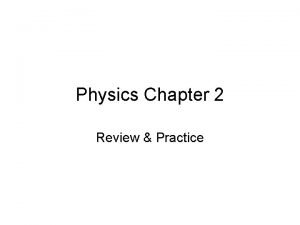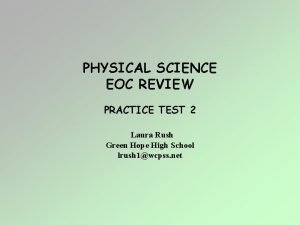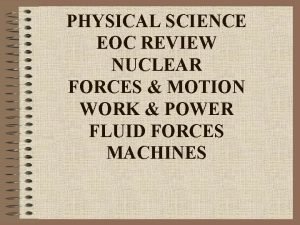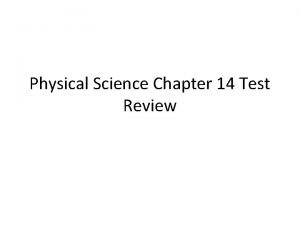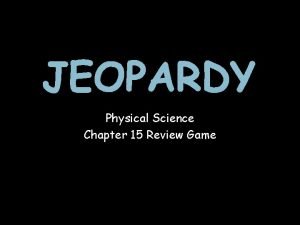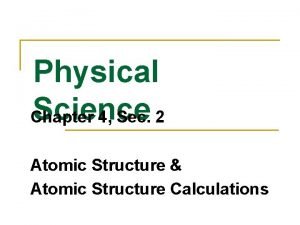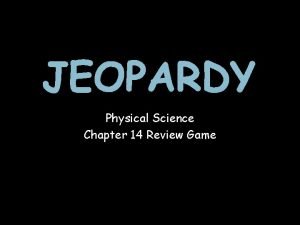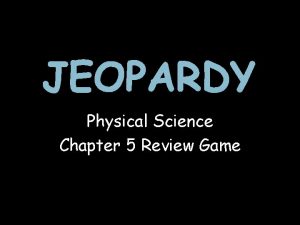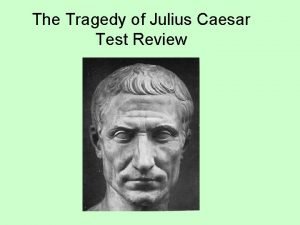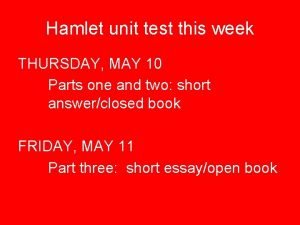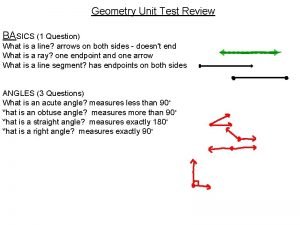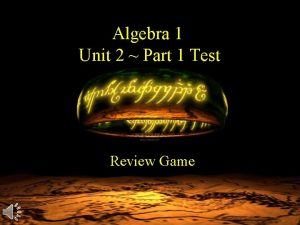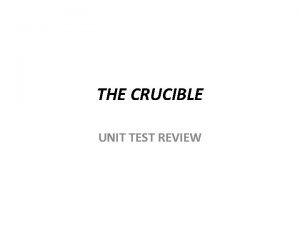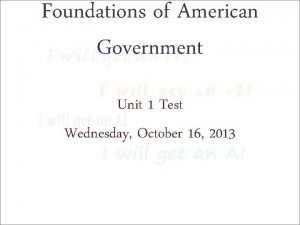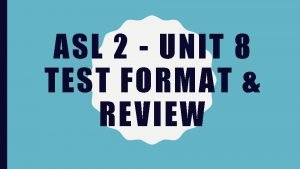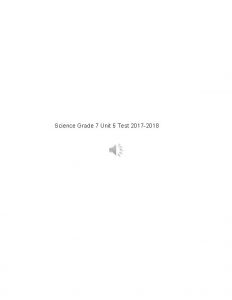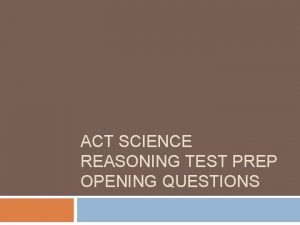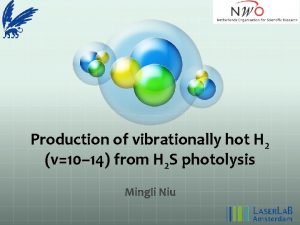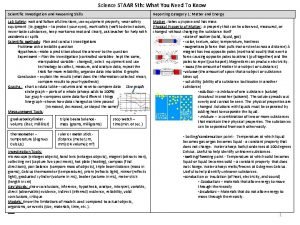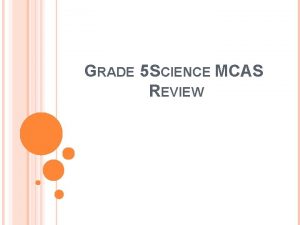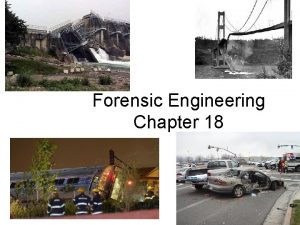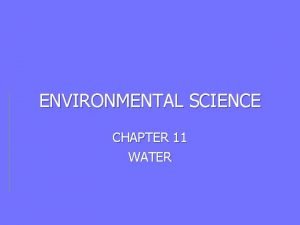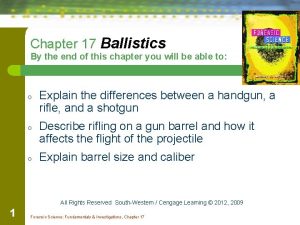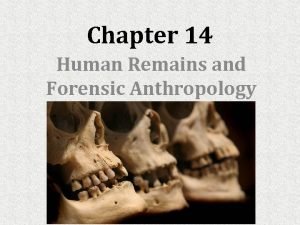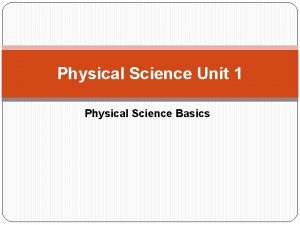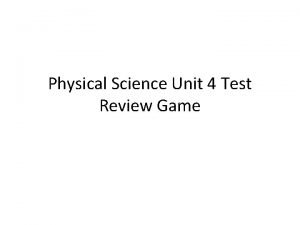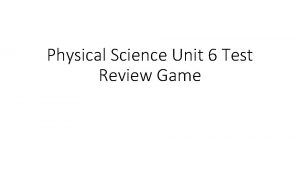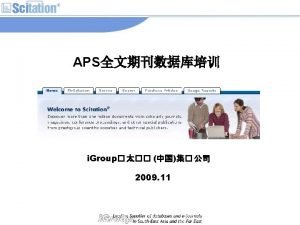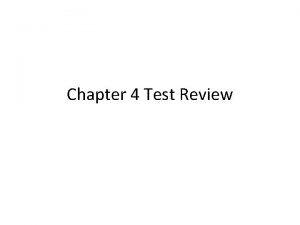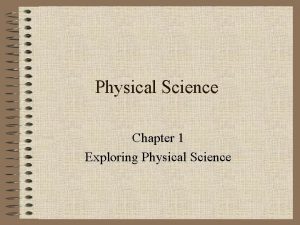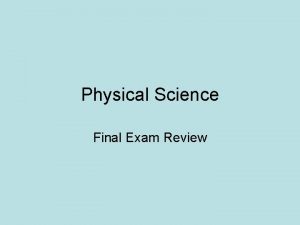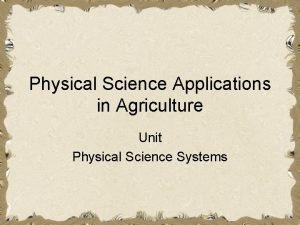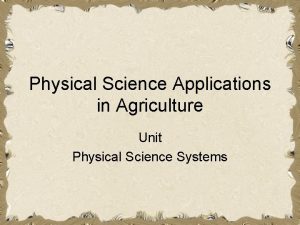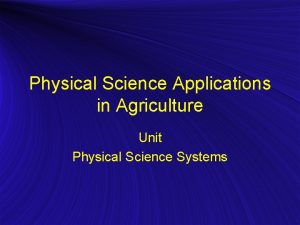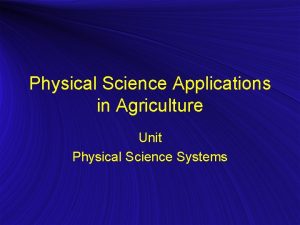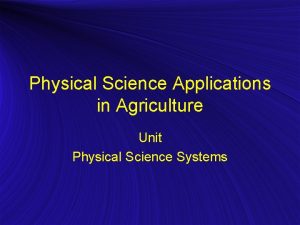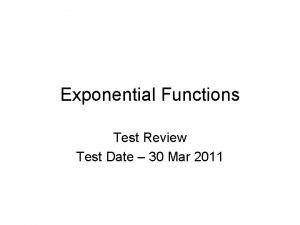Physical Science Unit 5 Test Review WarmUp Mar





























































- Slides: 61

Physical Science Unit 5 Test Review

Warm-Up Mar. 12 1. How many protons does sodium (Na) have? 2. How many electrons cant he 2 nd energy level hold? 3. What is Group 18 in the periodic table called?

Unit 5 Test Review • 1. Figure 5 -1 shows a portion of a blank periodic table. Identify the segments labeled A and B. • a. A is a group and B is a period. • b. A and B are both groups. A • c. A is a period and B is a group. • d. A and B are both periods. B c

Unit 5 Test Review • 2. Suppose you are looking at elements in the periodic table in this order: element 23, element 24, element 25, element 26, and so on. Are you looking across a period or down a group • a. period • b. group a • c. both a & b • d. neither a nor b

Unit 5 Test Review • 3. Which elements in Figure 5 -2 have the same number of valence electrons? • a. Na & Be • b. F & I • c. He & Na • d. C, N & F b

Unit 5 Test Review • 4. Which element in Figure 5 -2 is a transition metal? • a. V • b. Be • c. Na • d. He a

Unit 5 Test Review • 5. At room temperature all the elements in column 18 are • a. gas • b. liquid • c. plasma • d. solid a

Unit 5 Test Review • • • 6. Hydrogen is located in group 1 because ___ a. it is a metal b. there was no where else to put it c. it is the first element on the periodic table d. it has one valence electron d

Unit 5 Test Review • 7. The tendency of an element to react is closely related to • a. the number of valence electrons in atoms of the element. • b. attractions between its atoms. • c. its atomic mass. • d. the ratio of protons to neutrons in atoms of the element. a

Unit 5 Test Review • 8. As you move from left to right across a period, the number of valence electrons • a. stays the same. • b. increases and then decreases. • c. increases. • d. decreases. c

Unit 5 Test Review • 9. At room temperature, none of the metals are • a. malleable. • b. gases. • c. liquids. • d. soft. b

Unit 5 Test Review • 10. Which list of elements contains only metals? • a. carbon, iodine, tin • b. helium, iron, copper • c. tin, copper, cesium • d. iodine, carbon, argon c

Unit 5 Test Review • 11. Metal, Metalloid, or Nonmetal? Neon nonmetal

Unit 5 Test Review • 12. Metal, Metalloid, or Nonmetal? Gallium metal

Unit 5 Test Review • 13. What is the name of the group that Argon (Ar) is in? Noble gases

Unit 5 Test Review • 14. What is the name of the group that Iodine (I) is in? halogens

Unit 5 Test Review • 15. What is the name of the group that Calcium (Ca) is in? Alkaline earth metals

Unit 5 Test Review • 16. What is the name of the group that Chromium (Cr) is in? Transition metals

Unit 5 Test Review • 17. Which of the following is not a characteristic of the elements fluorine and chlorine? • A. brittle • B. malleable • C. gas at room temperature • D. good insulator b

Unit 5 Test Review • 18. What is unique for each element on the periodic table? • A. number of protons • B. number of neutrons • C. number of electrons • D. mass and charge a

Unit 5 Test Review • 19. Where on the periodic table are most of the nonmetals? • A. on the left • B. on the bottom • C. on the right • D. evenly distributed c

Unit 5 Test Review • • • 20. What period number is Barium in? A. 1 B. 2 C. 4 D. 5 E. 6 e

Unit 5 Test Review • 21. How many valence electrons does Iodine have? • A. 53 • B. 127 • C. 7 • D. 17 c

Unit 5 Test Review • 22. The pattern of repeating properties of elements revealed in the periodic table is known as • A. periodic law • B. periodic table • C. periodic rule • D. perioidicity a

Unit 5 Test Review • 23. True or False. Mendeleev’s periodic table was arranged based on atomic number, whereas the modern periodic table is arranged based on atomic mass. False

Unit 5 Test Review • • • 24. The unit for atomic mass is A. gram B. amu C. pound D. none of the above B

Unit 5 Test Review • • • 25. Group 17 of the periodic table contains the A. most reactive nonmetals. B. most reactive metals. C. least reactive nonmetals. D. least reactive metals. A

Unit 5 Test Review • 26. Atoms of the most reactive elements tend to have • A. one or seven valence electrons. • B. eight valence electrons. • C. four or five valence electrons. • D. no valence electrons. A

Unit 5 Test Review • 27. The tendency of an element to react is closely related to • A. its atomic mass. • B. attractions between its atoms. • C. the number of valence electrons in atoms of the element. • D. the ratio of protons to neutrons in atoms of the element. C

Unit 5 Test Review • • • 28. Which halogen is most likely to react? A. Br B. F C. I D. Cl B

Unit 5 Test Review • 29. Which of the following Group 1 elements is the most reactive? • A. Cs • B. Li • C. K • D. Na A

Unit 5 Test Review • 30. Fluorine forms a binary compound with lithium. What is the name of this compound? – A. lithium fluorine – B. lithium fluoride – C. fluorine lithium – D. fluorine lithide B

Unit 5 Test Review • 31. Which of the following elements is a noble gas? – A. Ne – B. F – C. C – D. Li A

Unit 5 Test Review • 32. Typically, atoms gain or lose electrons to achieve – A. ionization – B. vaporization – C. a stable electron configuration – D. an exchange of energy C

Unit 5 Test Review • 33. Covalent bonds are made of which of the following? – A. only metals – B. only nonmetals – C. both metals and nonmetals – D. all of the above B

Unit 5 Test Review • 34. In the name carbon dioxide, the prefix of the second word indicates that a molecule of carbon dioxide contains – A. a polyatomic ion – B. two oxygen atoms – C. two carbon atoms – D. an ionic bond B

Unit 5 Test Review • 35. an electron dot diagram, each dot represents a(an) _____. – A. neutron – B. oxidation number – C. proton – D. valence electron D

Unit 5 Test Review • 36. Which of the following groups contain three elements with stable electron configurations? – A. argon, neon, barium – B. xenon, neon, boron – C. lithium, krypton, argon – D. helium, xenon, neon D

Unit 5 Test Review • 37. The formation of an ionic bond involves the – A. transfer of neutrons – B. transfer of protons – C. transfer of electrons – D. sharing of electrons C

Unit 5 Test Review • 38. The compound whose formula is SO 3 is called – A. sulfur trioxide – B. sulfur oxygen – C. monosulfur trioxide – D. sulfur oxide A

Unit 5 Test Review • 39. In an ionic compound, the attractions between cations and _______ hold the compound together. – A. anions – B. transition elements – C. noble gases – D. metals A

Unit 5 Test Review • 40. Beryllium and chlorine form a binary ionic compound with a one-to-two ratio of beryllium ions to chloride ions. The formula for the compound is – A. Be. Cl 2 – B. 2 Be. Cl – C. Be 2 Cl 2 – D. Be 2 Cl A

Unit 5 Test Review • 41. The elements that make up a compound and the exact number of atoms of each element in a unit of the compound can be shown in a _____. – A. chemical symbol – B. subscript – C. superscript – D. chemical formula D

Unit 5 Test Review • 42. What is the total number of atoms in the compound Ca. Cl. O 3? – A. 2 – B. 3 – C. 4 – D. 5 D

Unit 5 Test Review • 43. What is the name of the compound with the formula Na. Cl? – A. chlorine sodium – B. sodium chlorate – C. sodium chloride – D. sodium dichloride C

Unit 5 Test Review • 44. What is the correct formula for magnesium oxide? – A. Mg. O – B. Mg. O 2 – C. Mg 2 O 2 – D. Mg 2 O A

Unit 5 Test Review • 45. Each molecule of table sugar, C 12 H 22 O 11, contains – A. 0 carbon atoms – B. 1 atom of carbon – C. 6 atoms of carbon – D. 12 atoms of carbon D

Unit 5 Test Review • 46. An anion has a ______ charge. – A. positive – B. negative – C. neutral – D. both positive and negative B

Unit 5 Test Review • 47. The name dinitrogen tetroxide tells you that this compound contains – A. two nitrogen atoms and two oxygen atoms – B. four nitrogen atoms and two oxygen atoms – C. two nitrogen atoms and four oxygen atoms – D. four nitrogen atoms and four oxygen atoms C

Unit 5 Test Review • 48. In the binary ionic compound potassium bromide, KBr, the element that forms cations is – A. bromine – B. potassium – C. potassium bromide – D. there is no cation B

Unit 5 Test Review • 49. True or False • Particles formed from the covalent bonding of atoms are called ions. False

Unit 5 Test Review • 50. True or False • When an atom gains or loses electrons, the charged particle that results is called a molecule. False

Unit 5 Test Review • 51. True or False • The formula SO 4 -2 stands for sulfur oxide. False

Unit 5 Test Review • 52. True or False • An atoms is chemically unstable when its outer energy level contains all the electrons it can hold. False

Unit 5 Test Review • 53. True or False • An element’s oxidation number indicates how many electrons the element must gain, lose, or share to become stable. True

Unit 5 Test Review • 54. True or False • In the binary ionic compound lithium iodide, Li. I, iodine would form the anions. True

Unit 5 Test Review • 55. True or False • The chemical formula for calcium chloride, Ca. Cl 2, shows that the compound contains two calcium ions for every chloride ion. False

Unit 5 Test Review • 56. True or False • KBr is the formula for an ionic compound. The fact that neither symbol is followed by a subscript means that there is a one-to-one ratio of ions in the compound. True

Unit 5 Test Review • 57. True or False • In sodium chloride, Na. Cl, the sodium ions are the cations. True

Unit 5 Test Review • 58. True or False • In the binary ionic compound potassium bromide, KBr, the element that forms cations is bromine. False

Unit 5 Test Review (BONUS) • 59. Match the following. You must get ALL of them right to get the points. 1. have a charge of -1 2. do not react 3. have 6 valence electrons 4. have 2 valence electrons 5. have a charge of +1 a. alkali metals b. alkaline earth metals c. group 16 1. d d. halogens 2. e 3. c e. noble gases 4. b 5. a
 Unit 6 review questions
Unit 6 review questions Unit test review algebra 2
Unit test review algebra 2 Warmup ratio
Warmup ratio Warmup 65
Warmup 65 Gmass warmup
Gmass warmup Status vs class
Status vs class Pyramid warmup
Pyramid warmup Warm rhyming words
Warm rhyming words Multiplication property of exponents
Multiplication property of exponents Java warmup
Java warmup Define:warmup
Define:warmup Persuasive essay quotes
Persuasive essay quotes Tinman schwartz
Tinman schwartz Warmup 65
Warmup 65 Warmup end
Warmup end Physrt
Physrt Physical science eoc review
Physical science eoc review Physical science eoc review
Physical science eoc review Chapter 4 work and energy section 1 work and machines
Chapter 4 work and energy section 1 work and machines Physical science chapter 14 test
Physical science chapter 14 test Physical science jeopardy
Physical science jeopardy Physical science chapter 4 review
Physical science chapter 4 review Chapter 14 review physical science
Chapter 14 review physical science Noah carried a skateboard
Noah carried a skateboard Chapter 5 review physical science
Chapter 5 review physical science Physical science chapter 6 review answers
Physical science chapter 6 review answers Chapter 16 review physical science
Chapter 16 review physical science Branches of science diagram
Branches of science diagram Natural and physical science
Natural and physical science My favorite subject is english
My favorite subject is english Forensic science unit
Forensic science unit The tragedy of julius caesar unit test review
The tragedy of julius caesar unit test review Unit test hamlet
Unit test hamlet Analytic geometry unit 1 test answers
Analytic geometry unit 1 test answers Function algebra unit test part 1
Function algebra unit test part 1 Elizabeth proctor was accused because _____.
Elizabeth proctor was accused because _____. Unit 1 test review us history
Unit 1 test review us history Foundations of american government unit 1 test review
Foundations of american government unit 1 test review Unit 8 test review
Unit 8 test review Romeo and juliet unit test review
Romeo and juliet unit test review Unit 6 test review algebra 1
Unit 6 test review algebra 1 Which of the following adaptations helps birds fly
Which of the following adaptations helps birds fly Science reasoning test
Science reasoning test Hyp opp adj
Hyp opp adj Chapter review motion part a vocabulary review answer key
Chapter review motion part a vocabulary review answer key Uncontrollable spending ap gov
Uncontrollable spending ap gov Narrative review vs systematic review
Narrative review vs systematic review Narrative review vs systematic review
Narrative review vs systematic review Narrative review vs systematic review
Narrative review vs systematic review Physical review a
Physical review a Physical review letters
Physical review letters Reporting category 3 earth and space
Reporting category 3 earth and space Earth science lab practical
Earth science lab practical Periodic table staar
Periodic table staar 5th grade science staar review
5th grade science staar review 5th grade science mcas
5th grade science mcas Forensic science chapter 18 review answers
Forensic science chapter 18 review answers Final exam environmental science
Final exam environmental science Chapter 11 water
Chapter 11 water Earth science sol review
Earth science sol review Nibis definition forensics
Nibis definition forensics Forensic anthropology unit
Forensic anthropology unit















